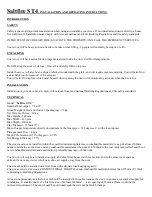
4
7038-206F
September 27, 2016
5700 STEP TOP ACC
Install Guide
2
Getting Started
A. Design and Installation Considerations
Consideration must be given to:
• Safety
• Convenience
• Traffic flow
• Chimney and chimney connector required
It is a good idea to plan your installation on paper, using exact
measurements for clearances and floor protection, before
actually beginning the installation. If you are not using an
existing chimney, place the appliance where there will be a
clear passage for a factory-built listed chimney through the
ceiling and roof.
We recommend that a qualified building inspector and your
insurance company representative review your plans before
and after installation.
If this appliance is in an area where children may be near it is
recommended that you purchase a decorative barrier to go
in front of the appliance. Remember to always keep children
away while it is operating and do not let anyone operate
this appliance unless they are familiar with these operating
instructions.
WARNING
• DO NOT CONNECT THIS APPLIANCE TO A CHIM
-
NEY FLUE SERVICING ANOTHER APPLIANCE.
• DO NOT CONNECT TO ANY AIR DISTRIBUTION
DUCT OR SYSTEM.
May allow flue gases to enter the house.
Asphyxiation Risk.
Check building codes prior to installation.
• Installation MUST comply with local, regional, state and
national codes and regulations.
• Consult insurance carrier, local building, fire officials or authori
-
ties having jurisdiction about restrictions, installation inspection,
and permits.
CAUTION
NOTICE:
HEARTH & HOME TECHNOLOGIES ASSUMES NO
RESPONSIBILITY FOR THE IMPROPER PERFORMANCE
OF THE APPLIANCE SYSTEM CAUSED BY:
• Inadequate draft due to environmental conditions
• Down drafts
• Tight sealing construction of the structure
• Mechanical exhausting devices
• Over drafting caused by excessive chimney heights
• Ideal performance is with height of chimney between 14-16
feet (4.26-4.88m) measured from the base of the appliance.
B. Fire Safety
To provide reasonable fire safety, the following should be
given serious consideration:
1. Install at least one smoke detector on each floor of
your home to ensure your safety. They should be
located away from the heating appliance and close
to the sleeping areas. Follow the smoke detector
manufacturer’s placement and installation instructions,
and be sure to maintain regularly.
2. A conveniently located Class A fire extinguisher to
contend with small fires resulting from burning embers.
3. A CO detector should be installed in the room with the
appliance.
4. A practiced evacuation plan, consisting of at least two
escape routes.
5. A plan to deal with a chimney fire as follows:
In the event of a chimney fire:
a Evacuate the house immediately
b. Notify fire department.





































